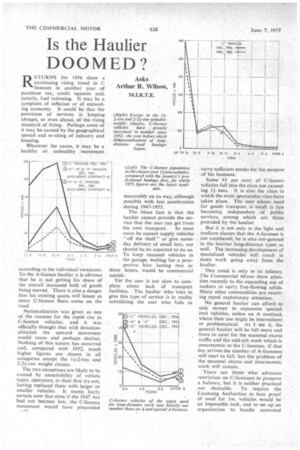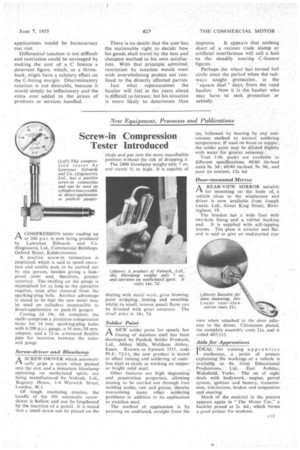Is the Haulier DOOMED?
Page 66

Page 69

If you've noticed an error in this article please click here to report it so we can fix it.
Asks Arthur R. Wilson,
M.I.R.T.E.
RETURNS for 195 show a continuing rising t end in C licences in anothe year of purchase tax credit sq eeze and, latterly, fuel rationing. I may be a symptom of inflation or of expanding economy. It could be that the provision of services is keeping abreast, or even ahead, of the rising standard of living. Perhaps some of it may be caused by the geographical spread and re-siting of industry and housing.
Whatever the cause, it may be a healthy or unhealthy movement according to the individual viewpoint. To the A-licence haulier it s obvious that he is not getting his share of i the overall increased bulk of goods being moved. There is also a danger that his existing quota will lessen as more C-licence fleets corrle on the road.
Nationalization . was given as one of the reasons for the rap d rise in C-licence vehicles, and it was officially thought that with denationalization the upward movement would cease and perhaps decline. Nothing of this nature has occurred and, compared with 1952, much higher figures are shown in all categories except the 14-2-ton and 2-2f-ton weight classes.
The two exceptions are likely to be caused by unsuitability of vehicle types, operators, in their first try-out, having replaced them with, larger or smaller vehicles. It seems fairly certain now that even if the 1947 Act had not become law, the C-licence movement would have proceeded inexorably on its way, although possibly with less acceleration during 1947-1953.
The . blunt fact is that the haulier cannot provide the service that the user can get from
• his own transport. In most cases he cannot supply vehicles " off the shelf" or give sameday delivery of small lots; nor should he be expected to do so. OVER 6 To keep manned vehicles in
the garage, waiting for a pros pective hire lasting two or three hours, would be commercial suicide. • Yet the user is not slow to com plain about lack of transport facilities. The haulier who tries to give this type of service is in reality subsidizing the user who fails to carry sufficient stocks for the purpose of his business.
Some 93 per cent. of• C-licence vehicles fall into the class not exceeding 14 tons. • It is also the class in which the most spectacular rises have taken place. The user whose need for goods transport is small is fast becoming independent of public services, among which are those provided by the haulier.
But it is not only in the light and medium classes that the A-licensee is out numbered; he is also out-gunned in the heavier long-distance types as well. The increasing development of specialized vehicles will result in more work going away from the haulier.
This trend is only in its infancy. The Commercial Motor drew atten• tion recently to the expanding use of tankers to carry free-flowing solids. Many other commodities are receiving equal exploratory attention.
No general haulier can afford to sink money in expensive specialized vehicles, unless on A contract, where their use might be intermittent or problematical. As I see it, the general haulier will be left more and more to cater for the seasonal excess traffic and the odd-job work which is uneconomic to the C-licensee. If that day arrives the number of A-licensees will start to fall, but the problem of the seasonal excess and Uneconomic work will remain.
There are those who advocate restriction on C-licensees to preserve a balance, but it is neither practical nor desirable. To require the Licensing Authorities to hear proof of need for lm. vehicles would be an impossible task, and to set up an organization to handle contested
applications would be bureaucracy run riot.
Differential taxation is not difficult and restriction could be envisaged by making the cost of a C licence a deterrent figure, which, as a throwback, might have a salutary effect on the C-hiring margin. Discriminatory taxation is not desirable, because it would simply be inflationary and the extra cost added to the prices of products or services handled. There is no doubt that the user has the inalienable right_ to decide how his goods shall travel by the best and cheapest method to his own satisfaction. With that principle admitted, restriction by taxation would meet with overwhelming protest not con. fined to the directly affected parties Just what repercussions the haulier will feel in the years ahead is difficult to foresee; but his situation is More likely to deteriorate than improve. It appears that nothing short of a vicious trade slump or artificial interference will call a halt to the steadily soaring C-licence figures.
Perhaps the wheel has turned full circle since the period when the railways sought protection, in the square deal" days; from the road haulier. Now it is the haulier who may have to seek protection or subsidy..












































































































